San Francisco holds a secure place in the United States’ romantic dream of itself—a cool, elegant, handsome, worldly seaport whose steep streets offer breathtaking views of one of the world’s greatest bays. According to the dream, San Franciscans are sophisticates whose lives hold full measures of such civilized pleasures as music, art, and good food. Their children are to be pitied, for, as the wife of publishing magnate Nelson Doubleday once said, “They will probably grow up thinking all cities are so wonderful.” To San Franciscans their city is a magical place, almost an island, saved by its location and history from the sprawl and monotony that afflicts so much of urban California.

Since World War II, however, San Francisco has had to face the stark realities of urban life: congestion, air and water pollution, violence and vandalism, and the general decay of the inner city. San Francisco’s makeup has been changing as families, mainly white and middle-class, have moved to its suburbs, leaving the city to a population that, viewed statistically, tends to be older and to have fewer married people. Now more than one of every two San Franciscans is “nonwhite”—in this case African American, East Asian, Filipino, Samoan, Vietnamese, Latin American, or Native American. Their dreams increasingly demand a realization that has little to do with the romantic dream of San Francisco. But both the dreams and the realities are important, for they are interwoven in the fabric of the city that might be called Paradox-by-the-Bay. Although San Franciscans complain of the congestion, homelessness, and high cost of living that plague the city and talk endlessly of the good old days, the majority still think of San Francisco the way poet George Sterling did, as “the cool grey city of love,” one of America’s most attractive, colourful, and distinctive places to live.
1. Golden Gate Bridge
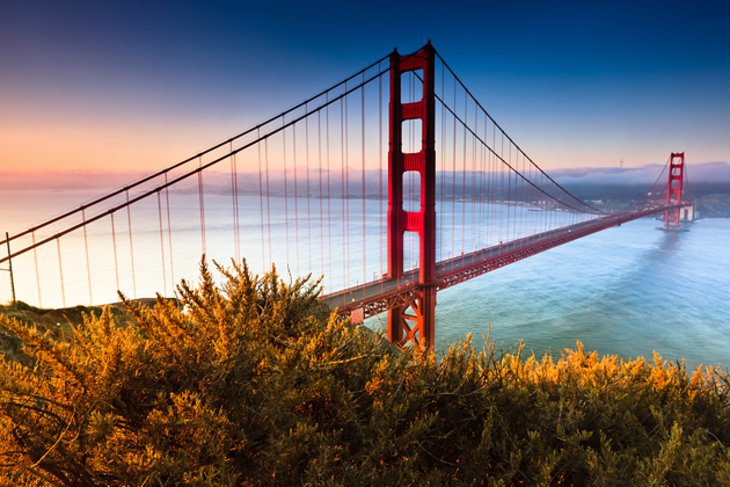
Golden Gate Bridge, suspension bridge spanning the Golden Gate in California to link San Francisco with Marin county to the north. Upon its completion in 1937, it was the tallest and longest suspension bridge in the world. Although other bridges have since surpassed it in size, it remains incomparable in the magnificence of its setting and is said to be the most photographed bridge in the world. It carries both U.S. Route 101 and California State Route 1 (Pacific Coast Highway) across the strait and features a pedestrian walkway. Its construction, under the supervision of chief engineer Joseph B. Strauss, began in January 1933 and involved many challenges. The strait has rapidly running tides, frequent storms, and fogs that made construction difficult. During one such fog on August 14, 1933, a cargo vessel collided with the access trestle, causing serious damage. Workers also had to contend with the problem of blasting rock under deep water to plant earthquake-proof foundations. A movable safety net, innovated by Strauss, saved a total of 19 men from falling to their deaths during construction. However, the safety net failed on February 17, 1937, when it gave way under the weight of a scaffolding collapse; of the 13 men who were on the scaffolding, one jumped clear, two survived the fall into the water, and 10 were killed. One other worker fell to his death during the construction, for a total of 11 worker deaths over four years. The bridge opened to vehicular traffic on May 28, 1937, under budget and ahead of schedule. The main span,1,280 metres (4,200 feet) long, is suspended from two cables hung from towers 227 metres (746 feet) high; at midpoint the roadway is 81 metres (265 feet) above mean high water. Until the completion of the Verrazano-Narrows Bridge in New York City in 1964, it had the longest main span in the world.
2. Alcatraz Island
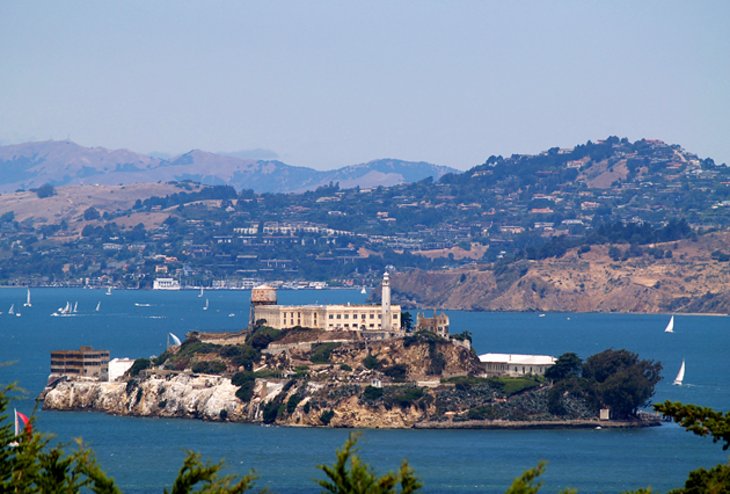
The historic and notorious Alcatraz penitentiary, located on Alcatraz Island in San Francisco Bay, is one of America's most infamous prisons. It operated for almost thirty years, closing in 1963 and re-opening as a tourist attraction in 1973. Some of America's most well-known criminals were inmates here, including Al Capone and the "Birdman," who would later form the basis for the fictional movie The Birdman of Alcatraz. You can take a ferry over to the island and tour the site while listening to an exceptional audio recording that offers a glimpse into life in the prison, rather than just a historical list of the facts. The narration is even voiced by former inmates and guards of Alcatraz. In the course of its 30-year existence, the penitentiary received a total of 1,576 convicts. There were never more than 250 at any one time, even though there were 450 cells measuring about 10ft x 4ft. At times the number of guards and staff was greater than the number of convicts. While most people come for the history or the novelty of seeing a former prison, the island is now a prominent area for nesting seabirds. An easy, convenient, and time-saving way to see Alcatraz and some of the other highlights of San Francisco, like Fisherman's Wharf, Chinatown, and the Golden Gate Bridge, is to take a combined Alcatraz and San Francisco City Tour. If you have only one day to explore the city, and Alcatraz is on your must-see list, this guided tour is the best option. Alcatraz regularly sells out, so booking in advance is strongly advised.
3. Fisherman's Wharf
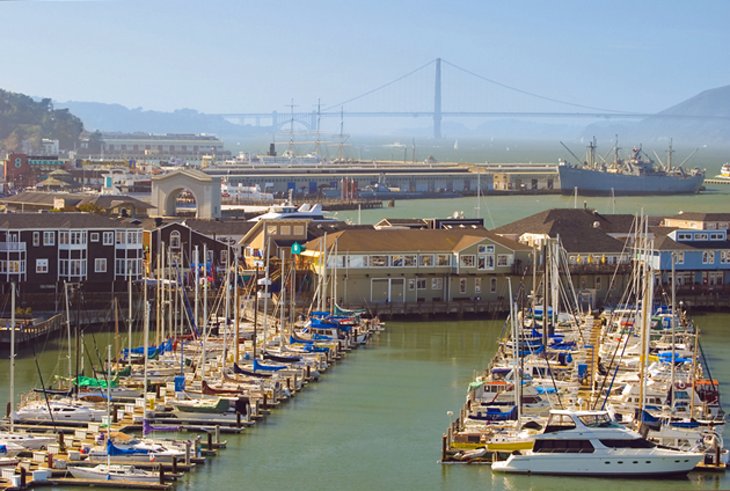
Fisherman's Wharf is one of San Francisco's most popular tourist areas. If this is your first visit to the city and you only have a day or two to see the sights, Fisherman's Wharf is one of the best places to visit. This old section, once the Little Italy of San Francisco, is known for its shops, restaurants, and beautiful setting along the waterfront. It's a fun place to stroll around and get a taste for the city. From here, you can also take a sightseeing cruise for spectacular views of the city, or organize a fishing charter. Some of the main attractions in the area are Madame Tussauds Wax Museum, Musée Mécanique, Ripley's Believe it or Not!, and Ghirardelli Square. Restored 19th- and 20th-century ships line the waterfront at the Hyde Street Pier, which is now the San Francisco Maritime National Historic Park. The USS Pampanito, a national historic landmark, is a WWII submarine and part of the San Francisco Maritime National Historic Park. Pier 39, located in this general area, is home to more than 130 stores and unique places to eat. It also offers great views looking back onto the city.
4. Ride the Cable Cars
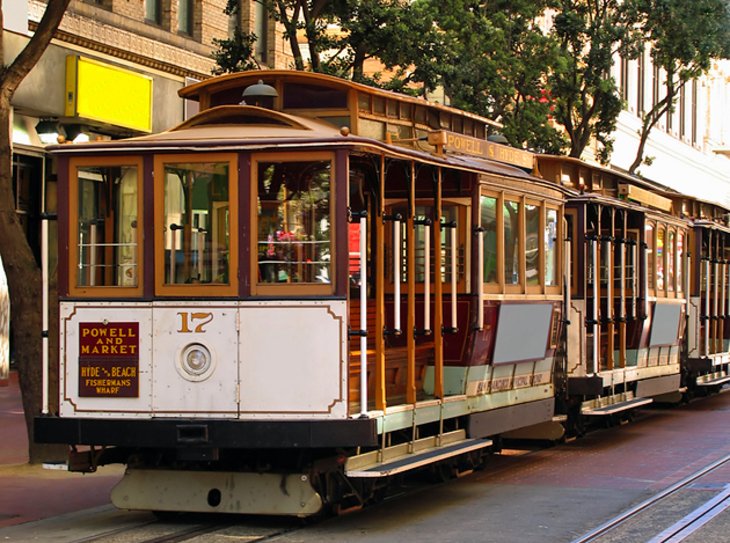
Cable Cars were introduced in 1873 to help locals contend with the many hills the city is built on. Today, the few remaining cable cars offer tourists a great way to explore the city in historic fashion. Since 1964, these tram-like vehicles have had the unique distinction of being the only public transport system to be declared a historic monument. The Powell-Mason and Powell-Hyde are the most scenic routes. The cable cars will also get you to the major tourist attractions such as Fisherman's Wharf, Ghirardelli Square, the Ferry Building, Nob Hill, and Lombard Street. If you are planning on more than a couple of rides or are going to be sightseeing for a few days, you should consider buying a pass. Riding the iconic San Francisco cable cars is one of the best things to do in the city. Why are most of the people on the car smiling? Because it really is a blast! This is a local's guide to riding the cable cars: how it all works and my tips for getting the most out of it.
Here are the most important things to know before getting on the cable cars...
- How to pay
- How to get on and off
- Which route to take
- How to avoid the lines
- How to save money on the tickets
5. Golden Gate Park
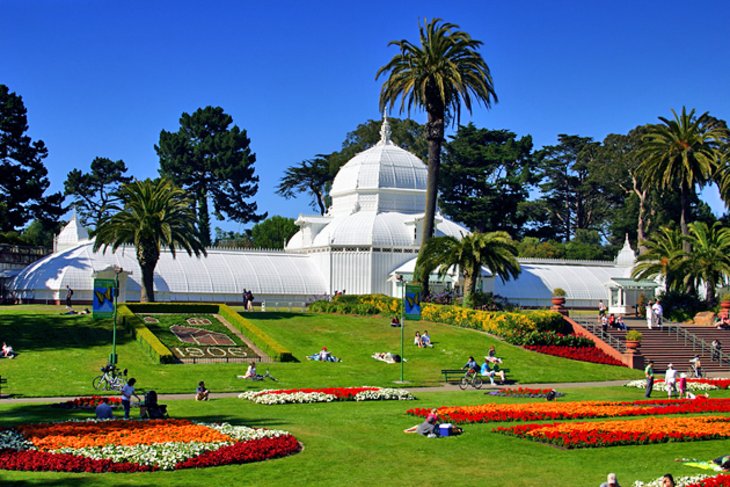
Golden Gate Park, home to gardens and museums, is a fabulous green space in the heart of San Francisco, often considered the "lungs" of the city. Before development began in 1871, this was an area of arid dunes. Today, the park has a network of walking trails and cycling paths, more than 5,000 different kinds of plants and dozens of species of trees, several lakes, bridle paths, and a buffalo paddock. The main attractions include the de Young Museum, the California Academy of Sciences Museum with Steinhart Aquarium, the Japanese Tea Garden, and the San Francisco Botanical Garden. Golden Gate Park is one of those places that can just as easily take up a couple of hours as a couple of days. Bike rentals are available, and this can be a good way to explore the park, rather than trying to do everything on foot. Alternatively, try an organized Segway Tour with a local guide and hit all the major highlights. Much as San Francisco's Golden Gate Bridge that was deemed "The Bridge That Couldn't Be Built", the 1,000+ acres of terrain once known as the "Outside Lands" wasn't a promising sight for a park. In 1871, field engineer William Hammond Hill and master gardener John McLaren carved out an urban oasis that was later named Golden Gate Park. Today, the park is home to a wealth of San Francisco's most-visited attractions, including the Japanese Tea Garden, the San Francisco Botanical Garden, the de Young Museum, and the California Academy of Sciences. Golden Gate Park sees more than 24 million visitors annually, making it the third most-visited city park in the United States.
6. Chinatown
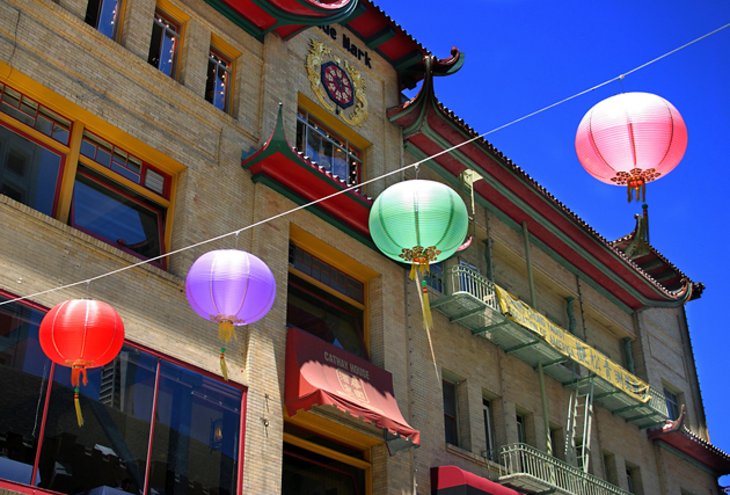
You may have been to Chinatown in other cities, but San Francisco's Chinatown is a whole other realm. It is both the largest Chinatown outside of Asia and the oldest of its kind in North America. Almost completely destroyed in the 1906 earthquake, Chinatown was rebuilt entirely in the Chinese style and was soon even more attractive than before the disaster. Now with its temples, theaters, workshops, small businesses, stores, antique and souvenir shops, teahouses, and traditional pharmacies, Chinatown has become one of the major sites of San Francisco. If you are traveling through San Francisco during an important Chinese holiday or event, you can expect to see an elaborate celebration. Chinese New Year celebrations are often considered the best in North America. The main street in Chinatown for tourists is Grant Avenue, with the Chinatown Gateway at Grant Avenue and Bush Street. One of the oldest and most established Chinatowns in the United States, Chinatown San Francisco boasts some of the city's best dim sum restaurants, galleries, tea shops and karaoke bars. From the Dragon Gate to China Live, Chinatown is a bustling neighborhoods with shops, boba spots and restaurants galore. Not to mention, it's also one of the most walkable neighborhoods in a city filled with hills. Starting in late 2019, the neighborhood will also be graced with the Central Subway line, a brand new Muni route that will run from the Caltrain station in SoMa to Chinatown’s 4th and King streets. It’s worth spending an afternoon wandering through Chinatown, San Francisco's colorful alleyways, treasure-packed shops, and vibrant markets. San Francisco’s Chinatown contains the largest Chinese population outside of Asia. As a result, the culture is robust, from arts organizations like the Chinese Cultural Center to the annual Chinese New Year festival every February. China Live, a two-story marketplace, retail space, food demonstration hall, and high-end bar and restaurant, is a must-see, as are the neighborhood’s quirkier, divier watering holes, like Buddha Lounge and Li Po Cocktail Lounge. Grant Avenue, the neighborhood’s main thoroughfare, is dotted with shops, bakeries, and grocers.
7. Legion of Honor
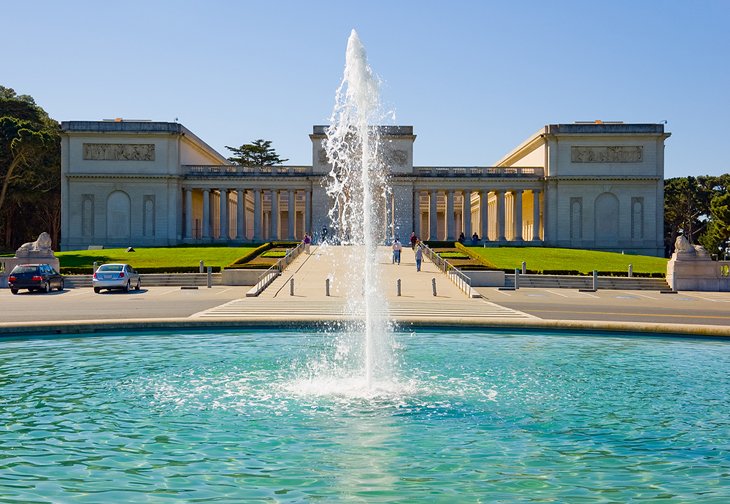
An impressive Neoclassical Beaux-Arts building in an amazing setting, the California Palace of the Legion of Honor is San Francisco's most exquisite museum. The Legion of Honor was the gift of the socialite, philanthropist, and patron of the arts Alma de Bretteville Spreckels. Because of her love for all things Parisian, the museum was designed as a replica of the Palais de la Légion d'Honneur in Paris. The Legion of Honor museum has a superb collection of European decorative arts, sculpture, and paintings, along with antiquities from the Mediterranean and Near East. Admission to this museum also gives you same-day admission to the de Young Museum. The museum is in Lincoln Park, a gorgeous green space with a golf course and coastal woodlands and a wonderful place for a leisurely walk. Just outside the museum, visitors may follow the path along Lincoln Highway, which boasts spectacular ocean vistas and perfect outlooks onto the Golden Gate Bridge. Those seeking a more adventurous hike can head to the Land's End Trail. This winding cliffside trail in a wild, rugged terrain offers sweeping Pacific Ocean views and panoramas of the Golden Gate Bridge.
Work hard 👌
ReplyDelete